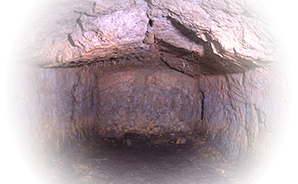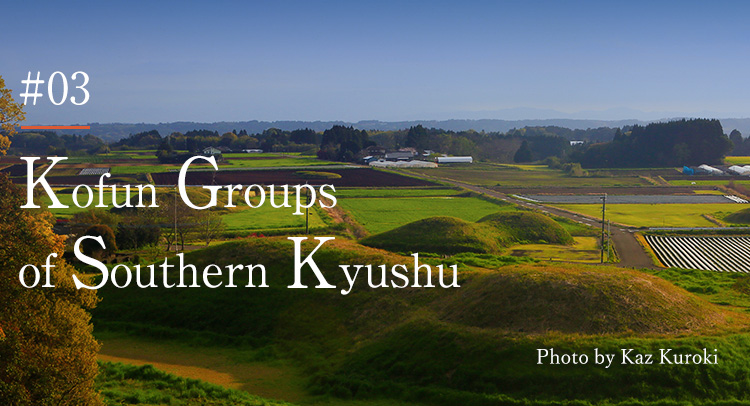Photo by Kaz Kuroki
Underground tunnel tombs/stone slab tombs
地下式横穴墓・板石積石室墓

地下式横穴墓・板石積石室墓
Underground tunnel tombs (Chikashiki Yokoana Bo)
Underground tunnel tombs represent a type of burial system particular to southern Kyushu, distributed in concentrations along the eastern side of southern Kyushu for a period of 3 centuries, from the end of the 4th century (Middle Kofun) until the 7th century (Final Kofun).
![Underground Tunnel Tombs(Shimauchi Underground Tunnel Tombs №21)[Ebino City]Photo by Ebino City Board of Education](../common/images/sec/burialmounds/photo02.jpg)
Underground Tunnel Tombs(Shimauchi Underground Tunnel Tomb No.21)[Ebino City]
( Photo by Ebino City Board of Education )
Underground tunnel tombs are a form of tomb in which a vertical pit was dug from the surface, from the bottom of which a separate adjoining chamber was dug in a horizontal direction, creating a burial chamber for the deposition of remains and grave goods. To date, over 1,000 underground tunnel tombs have been confirmed in Miyazaki Prefecture; however, the fact that these tombs are underground makes it highly likely that many remain undiscovered. As such, it is not possible at present to gain an accurate grasp of the true extent of these tombs.
On account of this burial system’s particularity to the southern Kyushu region, past commentators confused underground tunnel tombs with historical descriptions of the Kumaso and Hayato, two groups of people who lived in southern Kyushu in ancient times. As both the Kumaso and Hayato were opposed to the Yamato state, this led to the mistaken interpretation that underground tunnel tombs constituted a system of graves run by anti-centralist groups. However, the results of recent excavations paint a much different picture, showing how underground tunnel tombs coexisted with keyhole-shaped burial mounds in what could be called a pan-archipelagic burial system, as evinced from examples such as Ikime Kofun Group. What is more, the many diverse grave goods uncovered from these tombs reveal the existence of wide-ranging interaction with people from the Kinki and Setouchi regions, and as far as the Korean Peninsula and Nansei Islands.
Stone slab tombs (Itaishizumi Sekishitsu Bo)
Stone slab tombs represent a type of burial system particular to southern Kyushu, distributed in an area encompassing from northwestern Kagoshima Prefecture to the area surrounding Ebino and Hitoyoshi Plains, where they are mainly concentrated. Stone slab tombs were built from the latter half of the 4th century (Early Kofun) to the latter half of the 5th century (Middle Kofun). In Miyazaki Prefecture, around 20 of these tombs have been confirmed in Ebino City and Miyakonojo City.
![Stone Slab Tombs(Haiduka Stone Slab Tombs №1[Ebino City])](../common/images/sec/burialmounds/photo03.jpg)
Stone Slab Tombs(Haizuka Stone Slab Tomb No.1[Ebino City])
Stone slab tombs are a form of tomb in which a round or square burial pit was dug from the surface, and the sides of this pit were lined with stone slabs. Remains and grave goods were deposited in the burial pit and then sealed off with stone slabs to form a dome.
Various theories exist as to the origin of stone slab tombs, but they are thought to be a unique local burial system originating from the box-shaped stone coffins of the Yayoi period. While at present there are no known examples of stone slab tombs co-occurring with keyhole-shaped burial mounds, there are examples of them co-occurring with underground tunnel tombs. However, stone slab tombs do not present conspicuous evidence of grave goods suggesting close relations with royal authorities in the Kinai region or the existence of prominent clan chiefs. As such, this was a burial system formed within local society on an ongoing basis from the Yayoi period onward.





